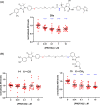Systematic Investigation of the Permeability of Androgen Receptor PROTACs
- PMID: 32832021
- PMCID: PMC7429968
- DOI: 10.1021/acsmedchemlett.0c00194
Systematic Investigation of the Permeability of Androgen Receptor PROTACs
Abstract
Bifunctional molecules known as PROTACs simultaneously bind an E3 ligase and a protein of interest to direct ubiquitination and clearance of that protein, and they have emerged in the past decade as an exciting new paradigm in drug discovery. In order to investigate the permeability and properties of these large molecules, we synthesized two panels of PROTAC molecules, constructed from a range of protein-target ligands, linkers, and E3 ligase ligands. The androgen receptor, which is a well-studied protein in the PROTAC field was used as a model system. The physicochemical properties and permeability of PROTACs are discussed.
Copyright © 2020 American Chemical Society.
Conflict of interest statement
The authors declare no competing financial interest.
Figures




References
-
- Tan L.; Gray N. S. When Kinases Meet PROTACs. Chin. J. Chem. 2018, 36 (10), 971–977. 10.1002/cjoc.201800293. - DOI
LinkOut - more resources
Full Text Sources
Other Literature Sources
Miscellaneous

